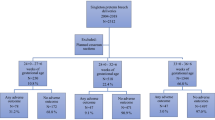Abstract
Objectives
To demonstrate the clinical course and the obstetric risk factors for umbilical cord prolapse.
Methods
The clinical course of reported cases of umbilical cord prolapse that occurred in Japan between 2007 and 2011 was retrospectively analyzed. The obstetric risk factors for umbilical cord prolapse were investigated by a nationwide population-based case-cohort study.
Results
Three hundred and sixty-nine cases (0.018 %) of fore-lying/prolapsed umbilical cord in 2,037,460 deliveries were analyzed. Most cases of fore-lying umbilical cord were diagnosed by an ultrasound scan (78 %), whereas umbilical cord prolapse was most frequently diagnosed by an internal examination (63 %). Umbilical cord prolapse was found to be significantly associated with the following factors: multiple pregnancy [odds ratio (OR) 3.57; 95 % confidence interval (CI) 2.60, 4.90], non-vertex presentation (OR 4.67; 95 %CI 3.73, 5.86), preterm labor (OR 2.28; 95 %CI 1.83, 2.83), premature rupture of membranes (OR 3.84; 95 %CI 3.10, 4.77), prolapsed amniotic bag (OR 12.31; 95 %CI 9.00, 16.85), polyhydramnios (OR 2.89; 95 %CI 1.49, 5.61), and a birth weight of <2500 g (OR 2.26; 95 %CI 1.84, 2.79).
Conclusion
The current study is the largest in Japan to demonstrate the obstetric clinical course and risk factors associated with umbilical cord prolapse. Prolapsed amniotic bag, labor and rupture of membrane during premature period, and fetal abnormal presentation induced by multiple pregnancy, and polyhydramnios were high risk situation for umbilical cord prolapse.






Similar content being viewed by others
References
Kahana B, Sheiner E, Levy A, Lazer S, Mazor M (2004) Umbilical cord prolapse and perinatal outcomes. Int J Gynaecol Obstet Off Organ Int Fed Gynaecol Obstet 84:127–132
Usta IM, Mercer BM, Sibai BM (1999) Current obstetrical practice and umbilical cord prolapse. Am J Perinatol 16:479–484
Critchlow CW, Leet TL, Benedetti TJ, Daling JR (1994) Risk factors and infant outcomes associated with umbilical cord prolapse: a population-based case-control study among births in washington state. Am J Obstet Gynecol 170:613–618
Huang JP, Chen CP, Chen CP, Wang KG, Wang KL (2012) Term pregnancy with umbilical cord prolapse. Taiwan J Obstet Gynecol 51:375–380
Holbrook BD, Phelan ST (2013) Umbilical cord prolapse. Obstet Gynecol Clin N Am 40:1–14
Boyle JJ, Katz VL (2005) Umbilical cord prolapse in current obstetric practice. J Reprod Med 50:303–306
Koonings PP, Paul RH, Campbell K (1990) Umbilical cord prolapse. A contemporary look. J Reprod Med 35:690–692
Hasegawa J, Sekizawa A, Ikeda T, Koresawa M, Ishiwata I, Kawabata M, Kinoshita K (2015) Group: Japan Association of O, Gynecologists (in press) Clinical risk factors for poor neonatal outcomes in umbilical cord prolapse. J Matern Fetal Neonatal Med 16:1–5 (Epub ahead of print)
Hasegawa J, Sekizawa A, Ikeda T, Koresawa M, Ishiwata I, Kawabata M, Kinoshita K, Group: Japan Association of O, Gynecologists (2015) The use of balloons for uterine cervical ripening is associated with an increased risk of umbilical cord prolapse: population based questionnaire survey in Japan. BMC Pregnancy Childbirth 15:4
Hayashi M, Nakai A, Satoh S, Matsuda Y (2012) Adverse obstetric and perinatal outcomes of singleton pregnancies may be related to maternal factors associated with infertility rather than the type of assisted reproductive technology procedure used. Fertil Steril 98:922–928
Unno S, Masuzaki H, Kanayama N, Kubo T, Fujimori K, Matsuda Y (2013) Report of perinatology committee. Acta Obstet Gynaecol Jpn 65:1377–1387
Murphy DJ, MacKenzie IZ (1995) The mortality and morbidity associated with umbilical cord prolapse. Br J Obstet Gynaecol 102:826–830
Katz Z, Lancet M, Borenstein R (1982) Management of labor with umbilical cord prolapse. Am J Obstet Gynecol 142:239–241
Lin MG (2006) Umbilical cord prolapse. Obstet Gynecol Surv 61:269–277
Acknowledgments
We are grateful to everyone who answered the present questionnaire survey, and who helped conduct and analyze the present study.
Author’s contribution
Hasegawa J., Sekizawa A. and Kinoshita K. designed the research. Hasegawa J., Sekizawa A., Ikeda T., Ishiwata I. and Kinoshita K. collected the data. Hasegawa J. and Sekizawa A. analyzed and interpreted the data, and drafted the manuscript. Hasegawa J. performed the statistical analyses.
Funding
The authors declare that they received no funding in association with the present study.
Author information
Authors and Affiliations
Consortia
Corresponding author
Ethics declarations
Conflict of interest
The authors declare no conflicts of interest in association with the present study. The authors do not receive any financial support, nor do they own stock in any of the companies related to the present study.
Ethical approval
This study was approved by the ethical board in the Japan Association of Obstetricians and Gynecologists. The present study was a retrospective analysis based on a questionnaire survey. Thus, the confidentiality of the patients involved was protected and no personal data was required for the present study.
Rights and permissions
About this article
Cite this article
Hasegawa, J., Ikeda, T., Sekizawa, A. et al. Obstetric risk factors for umbilical cord prolapse: a nationwide population-based study in Japan. Arch Gynecol Obstet 294, 467–472 (2016). https://doi.org/10.1007/s00404-015-3996-3
Received:
Accepted:
Published:
Issue Date:
DOI: https://doi.org/10.1007/s00404-015-3996-3




